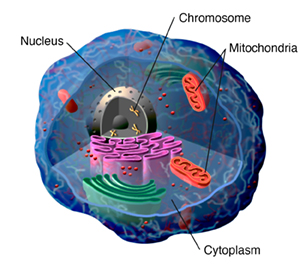Mitochondrial Inheritance: Leber Hereditary Optic Neuropathy
What is mitochondrial inheritance?
The chromosomes in the body are found in the center of the cells. This is called the nucleus. Outside of the nucleus are mitochondria. These are structures in the cytoplasm (liquid) of the cells. Mitochondria make energy for the cells. Mitochondria also contain their own genes that are separate from the ones in the nucleus.

Unlike nuclear genes, which are inherited from both parents, mitochondrial genes are inherited only from the mother. If all of the mother's cells have a mitochondrial mutation (including in her egg cells), she may pass it on to all of her children. Sons will not pass it on, but daughters may pass it on to all of their children. The first human disease that was linked to a mutation in mitochondrial DNA was Leber hereditary optic neuropathy (LHON).
What is Leber hereditary optic neuropathy (LHON)?
LHON causes a painless loss of central vision in both eyes due to the death of optic nerve cells. It leads to blindness in young adults, typically between ages 12 and 30. Both eyes are affected at the same time. Males are about 4 times more likely to be affected than females. Males will not pass the gene to any of their children, but females with the mutation will pass it to all of their children, regardless of whether the children are sons or daughters. Many factors affect the development of LHON. Both alcohol and tobacco use are associated with an increased risk for blindness in carriers of the mutation.


